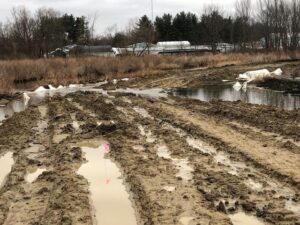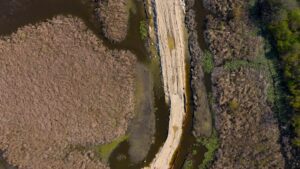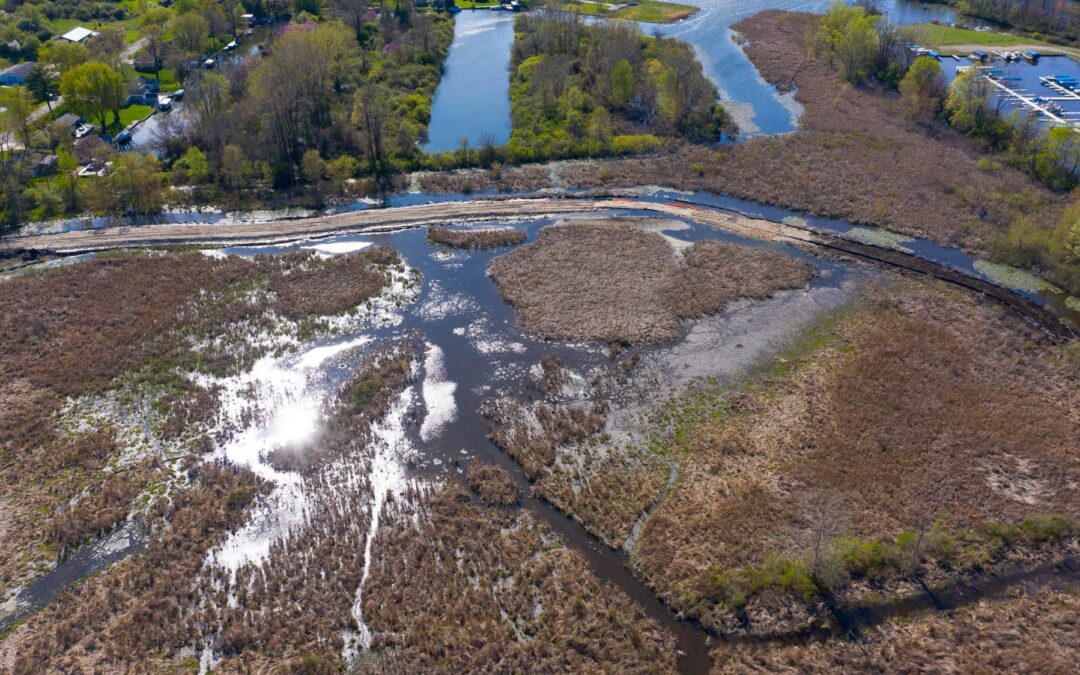The primary focus of the LMEF last year was fundraising for the Kline Levee Restoration Project. Thanks to state and local grants, and the generous giving of the community and lake supporters, we achieved our goal. After awarding the bid to The Stanger Group, construction began in the fall. The projected timeline for construction to be completed was by the end of the year, with seeding to be done in the spring of 2020. As you can imagine, we could barely contain our excitement as we watched this project begin.
The Kline Levee separates the Kline Wetland from the lake

However, you may have noticed that there has been little activity since January and the levee is only about two-thirds constructed. The area where the levee has failed multiple times in the past caused some issues and a different engineering design has been necessary. In addition, the unusually warm winter meant the ground did not freeze and the heavy equipment could not maneuver in the mud. The decision was made in mid-January to stop construction until conditions improved.
levee
A levee (/ˈlɛvi/), dike, dyke, embankment, floodbank or stopbank is an elongated naturally occurring ridge or artificially constructed fill or wall that regulates water levels. It is usually earthen and often parallel to the course of a river in its floodplain or along low-lying coastlines.
Wikipedia
We were literally dead in the water. We either needed the ground to freeze or the precipitation (snow/rain) to stop, neither of which has happened. Our contractor installed a robust, but temporary, solution for the problem area while we wait for both the weather to improve and a new engineered solution to be completed.

As soon as the ground is dry enough to support the equipment, construction will resume. Rest assured, the LMEC/LMEF is continually monitoring the situation and is anxious to get moving again. It looks like the project will be complete sometime this summer and we can have a ribbon cutting ceremony in conjunction with a wetlands tour in early fall. Stay tuned for the date and details. It will be a celebration!
Thank you to Jim Haist for the drone pictures of the levee. I can’t wait to post pictures of the finished product.

Hi, I’m Debbie Palmer. I received a BS in Horticulture from Purdue University. Here at LMEF, I am responsible for outreach presentations, monitoring the lake and it’s wetlands, project manager for restoration and research projects, and act as a community resource for all things related to the well-being of Lake Maxinkuckee and its surrounding watershed. I completed Indiana Watershed Leadership Academy, volunteer with the Indiana Clean Lakes Program, Hoosier River Watch and Marshall County Lakes and Waters and serve as a Board Member for Indiana Lakes Management Society.


Wonderful read! Thanks very much for the update!
Thanks. Good to know someone is reading my blog! LOL
Thank you for a job well done. I believe that there are many “investors” in the Max that read your reports.
Thanks for the comment. We take your “investment” quite seriously and do our best to be good stewards.
Thank you for the update on the watersheds that are part of maintaining our beautiful lake.